#renpet
Photo



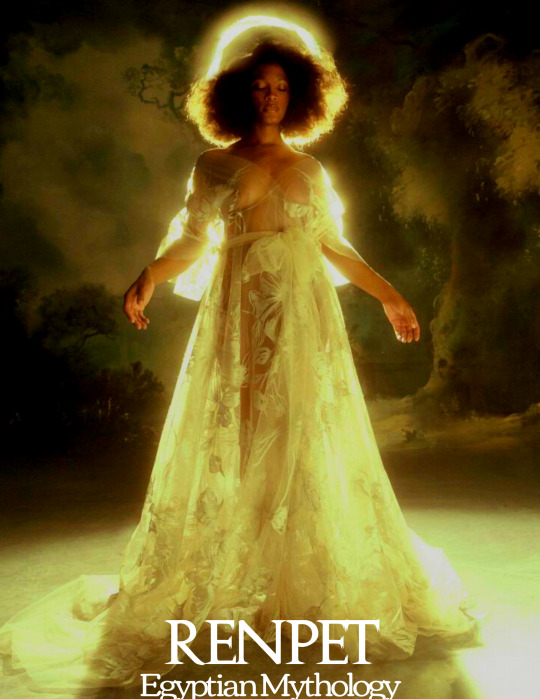






mythologies: spring deities
#greek mythology#persephone#eostre#germanic mythology#blodeuwedd#welsh mythology#renpet#egyptian mythology#xipe totec#aztec mythology#flora#roman mythology#idunn#norse mythology#jarylo#slavic mythology#gou mang#chinese mythology#belenus#cetic mythology#mythologyedit#mythedit#gods#goddesses#sorry if i missed any couldn't fit them
2K notes
·
View notes
Text


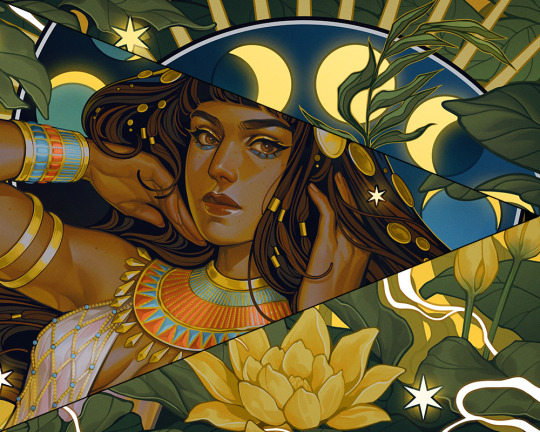
A couple of illustrations for a couple of artbooks (can't show them in full yet) and one future postcard ✨
#digital art#illustration#my art#artists on tumblr#mythology#ancient egypt#egyptian mythology#egyptian gods#hathor#renpet
342 notes
·
View notes
Text
pulled a few cards for set day and got the 3 of cups rx, the page of wands, the queens of pentacles and of swords... basically got told “fuck everyone else, do what you gotta do, you’ll be just fine and get farther than anyone” :’)
0 notes
Note
do we know how 'wepet renpet' was pronounced? because that's an incredible name, at least as transcribed in english. (i vaguely recall that we don't have vowels for a lot of the language, but i could be misremembering)
anyway i always appreciate seeing you on my dash, and thank you for sharing your expertise!
We don't really know how a lot of Ancient Egyptian was pronounced. However, I anglicised the Egyptian transliteration of wpt rnp.t and so you pronounce it exactly how it's written 'weh-pet ren-pet'. It means 'opening of the year'.
42 notes
·
View notes
Text

🩷 Knowledge of the Day: Wepet Renpet 🩷
#sonics schoolhouse#knowledge of the day#sshistory#amy rose#amy sonic the hedgehog#amy the hedgehog#sonic fanart#sonic the hedgehog#sonic the hedghog fanart#sonic#education
23 notes
·
View notes
Note
Biaankhi runs up to Larry and jumps up and down excitedly. “Wepet-Renpet! Wepet-Renpet!”
“Woooah slow down there buddy. What’s up?” Larry says, looking down to the boy. What could cause such an excitement for the boy? Wepet-Renpet?
#larry daley#night at the museum#natm#natm fandom#night guard#ask larry#ahkmenrah#ask box#ask me questions#bahiti
27 notes
·
View notes
Text
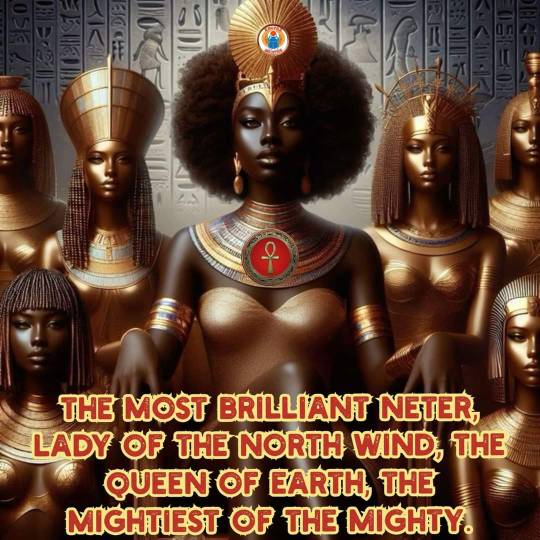
Hekaut: Invocation of the Neter ☥ ⚖ ☥
Come, you of beautiful forms, the crown is upon your head,
I salute you, arise!
You are upon your throne, you live in your sanctuary.
The words of magic are uttered from your mouth,
They bring life to the motionless, They dispel all abominations.
Auset Nebuut, Amenit, Menhet, Renpet Sep-et, Hetet, Hurt Thenenet, Ant, Sesheta Heget, Uadjit Mersekhen. Renpet Nebt Tept, T-hat Techetut, T-het, Shetat.
Nuk Ba Auset Ankh en Ma'at Udja Seneb Neb Hetupu ☥ ⚖ ☥
#khepraholistics
#rebirth
#Renewal
#transformation
#sacredmagicofancientegypt
#AusetSeason
6 notes
·
View notes
Text
🌿Correspondences for Ostara (Spring Equinox)🌿
🌿Other Names: Eostre, Eostre’s Day, Spring Equinox, Vernal Equinox, Alban Eiber, Bacchanalia, Lady Day
🌿Dates: March 19 – 22nd
🌿Colors: Pink, Yellow, Grass Green, All Pastels, Robin’s Egg Blue
🌿Altar Items: Eggs, Rabbits, Potted plants, Seeds, Maiden goddesses, Flowers, Quartz crystals, Cocoons, Bees, Baskets, Lambs, New Moon
🌿Activities: Conception, Egg painting, Gardening/planting a garden, Actualizing potential
🌿Spell Work: Manifestation, Healing, Energizing, Rededications, Removing obstacles, Restoring balance, Love attraction, Abundance, Home blessings, Spring cleaning
🌿Animals: Rabbits, Snakes, Chicks, Birds
🌿Stones: Aquamarine, Amethyst, Rose quartz, Moon stone, Bloodstone, Red jasper
🌿Foods: Eggs, Honey, Sprouts, Fresh fruits, Sweet breads, Seeds, Poppy Seed Cake, Banana bread, Chocolate, Sweet Wine, Milk and other dairy foods
🌿Herbs: Celandine, Cinquefoil, Jasmine, Rose, Tansy, Viole, Acorn, Crocus, Daffodil, Dogwood, Honeysuckle, Iris, Lily, Strawberry
🌿Trees: Birch, Ash, Alder
🌿Meaning: Balance, New Life/Rebirth, Goddes and God in Youth, Non-Celtic End of Winter, Light Overtaking Darkness, Fertility, Balance, New Beginnings, New Love, Growth,
🌿Ritual Oils: Lotus, Magnolia, Ginger
🌿Incense: Jasmine, Light scented florals
🌿Mythical Creatures: Mermaid, Dragons, Unicorn
🌿Goddesses: Aphrodite (Greek), Athena (Greek), Cybele (Roman), Eostre (Teutonic), Eriu (Irish), Gaia (Greek), Hear/Juno (Greco-Roman), Iris (Greek), Lady of the Lake (Welsh-Cornish), Madhusri (Hindu), Melusine (Franco-Scottish), Moon Mother (Native American), Ova (Greek-Etruscan), Renpet (Egyptian), Salamaona (Middle Eastern), Vesta (Greco-Roman), Anna Fearina (Roman), Astarte (Canaanite), Coatlicue (Aztec), Doda (Siberian), Erce (Slavic), Flidais (Irish), Garbhog (Irish), Ishtar (Babylonian), Isis (Egyptian), Libera (Roman), Ma-Ku (Chinese), Minerva (Roman), The Muses (Greek), Persephone (Greco-Roman), Rheda (Anglo-Saxon), Vesna (Slavic), Venus (Roman), Freya (Norse), Rati (Hindu)
#SpringEquinox #Ostara #Spring #pagan #Witchcraft #Witch
4 notes
·
View notes
Note
BLESSING OF RENPET!!! MAY YOU HAVE A PLENTIFUL SPRING!
Aw, I’m going to have to wait for September before my crops begin to flourish.
-🃏
5 notes
·
View notes
Photo
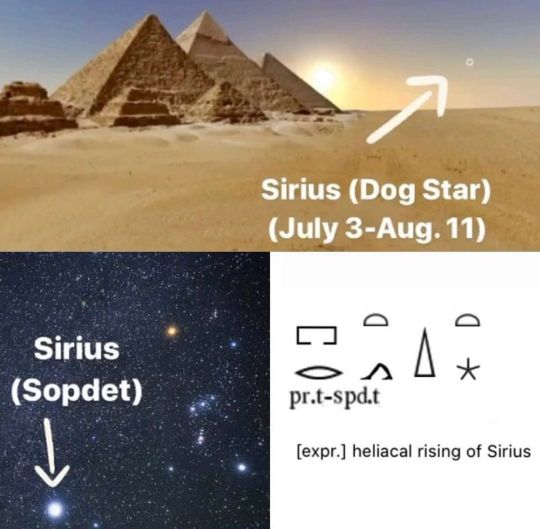
Sopdet 𓏚𓏏𓆇𓁐 “spd.t” is the ancient Egyptian 𓂋𓐝𓎀𓀂𓀭𓏪 “rmṯ” name of the star Sirius and its personification as an Egyptian goddess 𓊹𓏏 “nṯr.t”. Known to the Greeks as Sothis, she was conflated with Isis 𓊨𓏏𓆇 “3s.t” as a goddess and Anubis 𓇋𓈖𓊪𓅱𓃣 “inpw” as a god. Sopdet was depicted as a woman with a five-pointed star upon her head (photo 2), usually with a horned hedjet similar to Satis 𓋴𓄝𓏏𓏏𓁐 “stt” (photo 2 - A stellar goddess, possibly Sopdet, from the c. 1300 BC tomb of Seti I). Sopdet was also depicted as a reclining cow 𓇋𓎛𓏏𓃒 “ı͗ḥ.t” in a solar boat from the old kingdom and occasional throughout the ancient Egyptian history (photo 3 - Dandera ceiling) During the early period of Egyptian civilization, the heliacal rising of the bright 𓅱𓃀𓐍𓏏𓇶 “wbḫ” star 𓇼 “dw3” preceded the usual annual flooding 𓅱𓆓𓈖𓏌𓏲𓈗 “wḏnw” of the Nile 𓎛𓂝𓊪𓏭𓈘𓈗 “ḥpy”. It was therefore apparently used for the solar civil calendar which largely superseded the original lunar calendar in the 3rd millennium BC. Despite the wandering nature of the Egyptian calendar, the erratic timing of the flood from year to year, and the slow procession of Sirius within the solar year, Sopdet continued to remain central to cultural depictions of the year and to celebrations of Wep Renpet (Wp Rnpt), the Egyptian New Year 𓄋𓊪𓏏𓆳𓏏𓏤 “wp.t-rnp.t”. She was also venerated as a goddess of the fertility brought to the soil by the flooding. Sopdet is the consort of Sah, the personified constellation of Orion (photo 1) near Sirius. Their child Venus 𓋴𓃀𓇼𓍑𓄿 “sb3-ḏ (y)” was the hawk god Sopdu 𓏚𓅱𓀭 “spdw”, ‘Lord of the East’. As the "bringer of the New Year and the Nile flood", she was associated with Osiris 𓊨𓁹 “wsir” from an early date and by the Ptolemaic period Sah and Sopdet almost solely appeared in forms conflated with Osiris and Isis. #Egypt #egyptian #ancient #ancientegypt #hieroglyphics #ägypten #thisisegypt #egyptologist #myegypt #egyptianhistory #egyptology #hieroglyphs #madeinegypt #egypte #egyptians #egyptshots #loveegypt #discoveregypt #egitto #埃及 #مصر #egipto #constelation #sirius #dogstar #sopdet #astronomy #flooding #inundation https://www.instagram.com/p/Ck8ZZbOOJ_b/?igshid=NGJjMDIxMWI=
#egypt#egyptian#ancient#ancientegypt#hieroglyphics#ägypten#thisisegypt#egyptologist#myegypt#egyptianhistory#egyptology#hieroglyphs#madeinegypt#egypte#egyptians#egyptshots#loveegypt#discoveregypt#egitto#埃及#مصر#egipto#constelation#sirius#dogstar#sopdet#astronomy#flooding#inundation
17 notes
·
View notes
Text
Egyptian Mythological Figures to Use for Dislyte Ocs:
Aker, Amathaunta, Ammit, Amn, Anat, Anhur, Ani, Anuke, Apet, Astarte, Aten, Bat, Bennu, Besna, Denwen, Djefa, Dua, Fa, Hatmehit, Haurun, Hedetet, Hedjhotep, Heka, Heptet, Heneb, Heset, Iah, Iabet, Iat, Ihy, Imentet/Amentet, Iusaaset, Kebehut, Kek, Ken, Khepri, Khesfu, Kherty, Khnum, Khonsu, Kneph, Maahes, Maat, Mafdet, Mehen, Menhit, Imhotep, Meret, Meskhenet, Min, Mnevis, Montu, Mut, Kith, Nehmetawy, Nekhbet/Nekhebit, Nemty, Neper, Nepit, Nun, Pakhet, Pelican, Perit, Pesi, Petbe, Ptah, Qetesh, Rekhit, Renenet, Renpet, Fetket, Sait, Satet, Sehith, Seker, Sekhemus, Selkis, Sepa, Sepes, Seshat, Setem, Shed, Shehbui, Shezmu, Sopdu, Taweret, Tayt/Tayet, Tefnut, Tenenet, Thermuthis, Tjenmyt, Thmei, Uneg/Weneg, Unut, Usit, Wadjet/Uatchit, Wadj-wer/Wadjwer, Wosret,
Other: Amun (male form of Amunet), Anput (female form of anubis), Naunet (female version of Nun), Nebethetepet (female version of Atum), Temt (female version of Atum),
Note: Keep in mind that this list may not be accurate and/or may be missing some mythological figures because I put down what I knew and did the bare minimum of google searching.
#Dislyte#Dislyte oc#Dislyte oc’s#Mythological figures for Dislyte oc’s#Egyptian Gods#Egyptian Mythology#Egyptian Deities
18 notes
·
View notes
Text
I’ve just realised something
Amon Ra, Anubis, Khepri, Khnemu, Khonsu, Maahes, Osiris, Amunet, Anuket, Bastet, Hathor, Menhit, Pakhet, Tefnut, Wadjet, Wosret, Denwen, Fetket, Haurun, Khesfu, Kherty, Seta-Ta, Medjed, Shezmu, Sopdet, Wenenu, Heptet, Ishtar, Mafdet, Rekhit, Renpet, Sehith, Serket, Swenet, Tafner, Wepset
Every single one of these are Egyptian Deities. Every single one of these fits in with Homestuck Troll names, as evidenced by Serket. You could literally make fantrolls named after certain Egyptian Gods.
#I don’t know why this got me so much#Wow that’s a lot of Homestuck gods#Supposing. they followed this instead of zodiacs#Serket was a scorpion god rather than a spider god which is interesting#they’re both arachnids though#Homestuck
2 notes
·
View notes
Text
Gods and Goddesses List
List of Goddesses (not counting closed cultures)
Greek: 44
Roman: 23
Norse/Celtic: 43
Egyptian: 40
Sumerian/Mesopotamian: 19
Hindu: 12
Aditi (Hindu)
Andraste (Celtic)
Aine (Irish)
Althea (Greek)
Airmid (Irish)
Aramati (Hindu)
Ama (Sumerian)
Amaunet (Egyptian)
Amaterasu (Japanese)
Ammit (Egyptian)
Anat (Canaanite)
Anut (Egyptian)
Arachne (Greek)
Ashtar (Mesopotamian)
Arianhod (Welsh)
Amphitrite (Greek)
Ananke (Greek)
Apate (Greek)
Aurora (Roman Eos)
Asherah (Hebrew)
Ashnan (Sumerian)
Astraea (Greek)
Aunket (Egyptian)
Aphrodite (Greek)
Artemis (Greek)
Asteria (Greek)
Athena (Greek)
Atlanta (Greek)
Badb (Irish)
Branwen (Welsh)
Bastet (Egyptian)
Bata (Egyptian)
Bellona (Roman)
Bharati (Hindu)
Brigid (Irish)
Blodeuwedd (Welsh)
Baubo (Greek)
Cailleach (Scottish)
Carmenta (Roman)
Cear Ibormeith (Irish)
Ceres (Roman Demeter)
Cerridwen (Irish)
Circe (Greek)
Concordia (Greek)
Coventina (English)
Damkina (Sumerian)
Damara (Celtic)
Danu (Irish)
Demeter (Greek)
Deshtri (Hindu)
Devi (Hindu)
Diana (Roman Artemis)
Dike (Greek)
Discordia (Roman Eris)
Durga (Irish)
Egeria (Roman)
Eir (Norse)
Elen (Welsh)
Epona (Irish)
Eos (Greek)
Eris (Greek)
Eirenne (Greek)
Ereshkigal (Sumerian)
Erinyes (Greek)
Fides (Roman)
Filadia (Irish)
Fortuna (Roman)
Frau Holle (Germanic)
Freyja (Norse)
Frigg (Norse)
Fulla (Norse)
Gaia (Greek)
Greek Muses (Greek)
Gefjon (Norse)
Green Tara (Buddhism)
Gula (Sumerian)
Gwendydd (Celtic)
Harmonia (Greek)
Hathor (Egyptian)
Hatmehit (Egyptian)
Hecate (Greek)
Hedetet (Egyptian)
Heket (Egyptian)
Hel (Norse)
Henwen (English)
Heqet (Egyptian)
Hera (Greek)
Hebe (Greek)
Hemera (Greek)
Hestia (Greek)
Hygeia (Greek)
Ida (Greek)
Idunn (Norse)
Iris (Greek)
Inanna (Sumerian)
Indrani (Hindu)
Isthar (Mesopotamian)
Isis (Egyptian)
Iuasaas (Egyptian)
Juno (Roman Hera)
Juventas (Roman Hebe)
Kali (Hindu)
Ki (Sumerian)
Kwan Yin (Chinese)
Kauket (Egyptian)
Lakshimi (Hindu)
Leto (Greek)
Lilith (Hebrew)
Luna (Roman Selene)
Ma’at (Egyptian)
Maeve (Irish)
Mabb (Welsh)
Macha (Irish)
Maia (Greek)
Maitri (Hindu)
Mafdet (Egyptian)
Medusa (Greek)
Mnemosyne (Greek)
Medb (Irish)
Mehet Weret (Egyptian)
Menhit (Egyptian)
Meretseger (Egyptian)
Meskhenet (Egyptian)
Metis (Greek)
Minerva (Roman Athena)
Morgen Le Fey (Welsh/Briton)
Morrigan (Irish)
Mother Mary (Christian)
Mut (Egyptian)
Nahmauit (Egyptian)
Namagiri (Hindu)
Nammu (Sumerian)
Nanna (Norse)
Nanshe (Sumerian)
Neith (Egyptian)
Nehalennia (Germanic)
Nekhbet (Egyptian)
Nemesis (Greek)
Nephthys (Egyptian)
Ninhursag (Sumerian)
Nidaba (Sumerian)
Ninlil (Sumerian)
Ningal (Sumerian)
Nisaba (Sumerian)
Ninkasi (Sumerian)
Nike (Greek)
Nott (Norse)
The Norns (Norse)
Nut (Egyptian)
Nyx (Greek)
Olwen (Celtic)
Ostara (Germanic)
Pandora (Greek)
Parvati (Hindu)
Pakhet (Egyptian)
Pax (Roman Eirene)
Persephone (Greek)
Proserpina (Roman Persephone)
Phoebe (Greek)
Phanes (Greek)
Pomona (Roman)
Pontos (Greek)
Psyche (Greek)
Pythia (Greek)
Rati (Hindu)
Rhea (Greek)
Renenet (Egyptian)
Renpet (Egyptian)
Rhiannon (Welsh)
Saraswati (Hindu)
Salacia (Roman Neptune wife)
Salus (Roman Hygeia)
Satet (Egyptian)
Sarpanit (Sumerian)
Sekhmet (Egyptian)
Selene (Roman)
Serket (Egyptian)
Selkis (Egyptian)
Seshat (Egyptian)
Shelia-na-gig (Irish)
Sif (Norse)
Sirtir (Sumerian)
Sita (Hindu)
Sigyn (Norse)
Skadi (Norse)
Skuld (Norse)
Sopdet (Egyptian)
Taweret (Egyptian)
Tayet (Egyptian)
Tefnut (Egyptian)
Tellus (Roman Gaia)
Theia (Greek)
Themis (Greek)
Tiamat (Sumerian)
Trivia (Roman Hecate)
Tyche (Roman Fortuna)
Wadjet (Egyptian)
Wosyet (Egyptian)
Unut (Egyptian)
Venus (Roman Aphrodite)
Vesta (Roman Hestia)
Victoria (Roman Nike)
Voluspa (Norse)
List of Gods (not counting closed cultures)
Greek: 21
Roman: 9
Norse/Celtic: 15
Egyptian: 20
Sumerian/Mesopotamian: 8
Hindu: 11
Achilles (Greek)
Adonis (Greek)
Anhur (Egyptian)
Apollo (Greek)
Apollo (Roman)
An (Sumerian)
Amergin (Irish)
Amon (Egyptian)
Amun Ra (Egyptian)
Asclepius (Greek)
Anubis (Egyptian)
Angus (Irish)
Ares (Greek)
Archangel Azrael (Christian)
Atlas (Greek)
Bacchus (Roman Dionysus)
Baldr (Norse)
Bes (Egyptian)
Brahma (Hindu)
Bragi (Norse)
Buddha (Buddhism)
Cernunnos (Celtic)
Chronos (Greek)
Dadga (Irish)
Diancecht (Irish)
Dionysus (Greek)
Dyaus (Hindu)
Ea (Sumerian)
Enki (Sumerian)
Enlil (Sumerian)
Eros (Greek)
Erebos (Greek)
Evander (Greek)
Echidna (Greek)
Fenrir (Norse)
Archangel Gabriel (Christian)
Ganesha (Hindu)
Geb (Egyptian)
Gilgamesh (Sumerian)
Green Man
Goibhniu (Irish)
Hades (Greek)
Hanuman (Hindu)
Helios (Greek)
Hesperides (Greek)
Hephaestus (Greek)
Hercules (Greek)
Hermes (Greek)
Horus (Egyptian)
Hu (Egyptian)
Hyperion (Greek)
Hypnos (Greek)
Indra (Hindu)
Jesus (Christian)
Jupiter (Roman Zeus)
Kama (Hindu)
Khonsu (Egyptian)
Krishna (Hindu)
Khnum (Egyptian)
Khepri (Egyptian)
Loki (Norse)
Archangel Lucifer (Christianity)
Lugh (Irish)
Mars (Roman Ares)
Archangel Metatron (Christian)
Mercury (Roman Hermes)
Min (Egyptian)
Archangel Michael (Christian)
Nabu (Sumerian)
Nanna (Sumerian)
Narcissus (Greek)
Neptune (Roman Poseidon)
Nuada (Irish)
Odin (Norse)
Oghma (Irish)
Ouranos (Greek)
Orion (Greek)
Osiris (Egyptian)
Pan (Greek)
Perseus (Greek)
Poseidon (Greek)
Pluto (Roman Hades)
Prometheus (Greek)
Ptah (Egyptian)
Ra (Egyptian)
Archangel Raphael (Christian)
Saturn (Roman Chronos)
Shamash (Mesopotamian)
Shiva (Hindu)
Set (Egyptian)
Sia (Egyptian)
Sobek (Egyptian)
Shu (Egyptian)
Thor (Norse)
Thoth (Egyptian)
Typhon (Greek)
Tvastri (Hindu)
Tyr (Norse)
Archangel Uriel (Christian)
Utu (Mesopotamian)
Varuna (Hindu)
Vishnu (Hindu)
Vulcan (Roman Hephaestus)
Zeus (Greek)
Greek total: 65
Roman total: 32
Norse/Celtic total: 58
Egyptian total: 60
Sumerian/Mesopotamian total: 27
Hindu total: 23
Goddesses: 195
Gods: 95
Total: 290
2 notes
·
View notes
Text

Egyptian calendar arises at the beginning of 3rd Millennium BC and is the first known solar calendar in history.
It was in full use at the time of Shepseskaf, the pharaoh of the Fourth Dynasty.
In Pyramid Texts, the 365 days of the Egyptian civil year are mentioned. It was divided into 12 months of 30 days each, organized into three groups of ten.
At the end of the last month of each year, the five days (epagomena) that were left to complete the solar year were added — dedicated to various Egyptian gods.
“The Egyptians were the first of all men who discovered the year, and they said that they found this from the stars.” (Herodotus Histories II-4)
As Egyptian civil calendar did not have the fourth day that the astronomical solar year has in excess, every four years, it lost a day, so it became a “wandering calendar,” where “astronomically fixed periodic” events roamed through the months of calendar.
Since the dawn of the Empire, Egyptian priests carefully recorded the level of the waters, which they measured with nilometers.
Timing of sowing or harvesting depended on it, and after years of observations, they discovered that the cycle repeated every 365 days.
In Herodotus’s words: Egypt was a gift from the Nile.
This comment is not a literary image but a reality.
Annual river floods caused by the monsoon flooded the fields, covering the desert sands with fertile silt.
In Egypt, various calendars – Lunar, Solar (civil), and possibly a third secondary lunar calendar – were used to accurately calculate ephemeris.
Egyptian astronomical priests discovered that lunar calendars were not practical to predict the beginning of Nile floods, calculate the seasons, or count long periods, then comparing them with a measurement referring to the apparent movement of the Sun and the stars, they preferred to use the solar calendar for civil uses for the first time in history.
Egyptians may have used a lunar calendar before, but when they discovered the discrepancy between the lunar calendar and the regular passage of the seasons, they probably switched to a seasonal calendar, basing their regular onset on each annual Nile flood.
First flood according to The Calendar was observed in the first capital of Egypt, Memphis, at the same time as the heliacal rising of the star Sopdet (Sirius).
Egyptian year was divided into the three seasons of an agricultural nature:
• Flood (late summer and fall)
• Sowing (winter and early spring)
• Harvesting (late spring and early summer)
Astronomers in Middle Ages used Egyptian calendar because of its mathematical regularity.
Nicolaus Copernicus, for example, built his tables for the movement of planets based on measurement of time with Egyptian year.
Egyptian civil calendar had three seasons of four months of thirty days, plus five epagomenal days.
Only after the New Kingdom will the months of the civil calendar have their own names.
Name of months underwent variations over time, as well as the exact date of the beginning of the year.
The name given to each of the twelve months corresponds to the time of the New Kingdom.
Plus, five Heru-Renpet days (“those that are above the year” or epagomenal days), from August 24 to 28.
They were also known as (“of the birth of the gods”), since the birth of five Egyptian deities was celebrated in them: Osiris, Horus, Seth, Isis, and Nephthys.
Later, in the Coptic language , they were called Piabot Nkoyxi (“the little month”).
© Historical Eve
#Egyptian calendar#solar calendar#Shepseskaf#Ancient Egypt#ancient civilizations#Herodotus Histories#Nicolaus Copernicus#Piabot Nkoyxi#Egyptian deities#Egyptian priests
1 note
·
View note
Text
In 4236 B.C.E the Egyptian Solar Calendar was invented. Consisting of 365 days this indicates 4236 B.C.E as the earliest recorded year. The solar calendar worked by indicating the date based upon the position of the sun. Ancient Egyptian years consisted of 3 seasons that were 4 months each with an additional 5 days added at the end of the year to honor their gods. There were 3 seasons: Ahket “the time of the floods”, Peret “the time of growth”, and Shemu “the time of harvest”. The Egyptians also had a name for each of the 12 months- Tekh, Menhet, Hwt-Hrw, Ka-Hr-Ka, Sf-Bdt, Rekh Wer, Rekh Neds, Renwett, Hnsw, Hnt-Htj, Ipt-Hmt, and lastly Wep-Renpet. The invention of the Solar calendar allowed the Ancient Egyptians to more carefully plan their crops and harvest as well as be cautious of the flooding season, resulting in a surplus of food and less deaths.
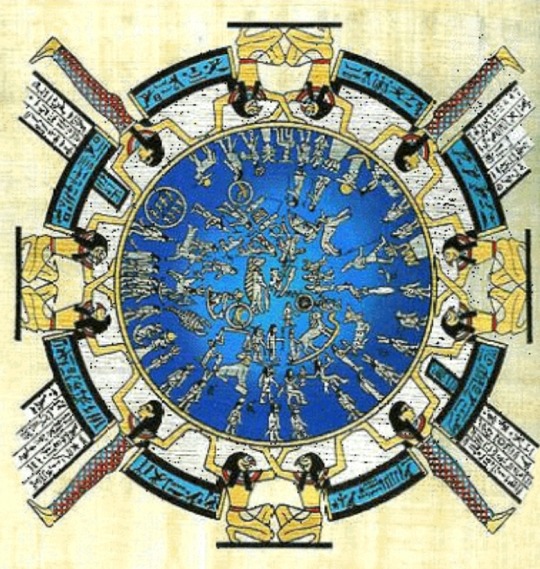
In early Ancient Egypt many Egyptians looked to their goddess Ma’at and lived their lives accordingly in balance of the basic principles, however there were still those who didn’t fall in line with the majority of the population and would choose to put the selfish desires of oneself before the well-being of the population which resulted in the occupation of guards. It began with the wealthy hiring guards to protect their belongings, property, family or self but towards the end of the 5th dynasty this transitioned to kings and nobles hiring guards from the military or ex-military tasked with guarding public places such as markets and temples in an attempt to lower crime rates. Early Egyptian police also made use of dogs and monkeys to apprehend those who opposed the principles.

Ancient Egyptians were very crafty, and the papyrus scroll is an excellent example. Made from thin strips of the papyrus reed which had been overlapped and pressed together, papyrus scrolls emerged. Many scribes and scholars used papyrus scrolls and codex’ to record important information such as the bible and law. Eventually papyrus was replaced with parchment, however papyrus scrolls and codex still hold a very significant place in history, the earliest records.

1 note
·
View note
Text
Egyptians New Year Day
Egyptians New Year Day the Egyptian New Year was celebrated on the first day of the month of Thoth, the first month of the Egyptian calendar. Thoth was the god of wisdom and knowledge, and the Egyptians believed that this month was a time of renewal and rebirth. The celebration was called “Wep Renpet” which means “opening of the year” or “year-beginning”. The date of the Egyptian New Year varied throughout history and depended on the occurrence of the annual flooding of the Nile. The New Year’s celebration was a time for offering gratitude to the gods for the blessings of the past year and for asking for their help and protection in the coming year. People would visit the temples of the gods and exchange gifts with their loved ones. They would often wear new clothes and decorate their homes to mark the occasion. The priests of the temples would perform rituals to mark the beginning of the New Year, including purifying the temple with natron and lighting fires to honor the god Ra. The pharaoh would also perform a ritual in which he would strike the ground with a hoe to symbolize the renewal of life and fertility.
(Wepet-Renpet Festival): also known as the “Opening of the Year,” was a significant event in the Ancient Egyptian calendar and marked the beginning of the agricultural year. The date varied depending on the heliacal rising of the star Sirius, which usually occurred in mid-July. The festival was celebrated for several days, with the main focus being on the renewal of life, fertility, and rebirth. People would clean their homes, wear new clothes, and adorn their houses with greenery such as branches of palm, willow, and myrtle. They also exchanged gifts and feasted with their families and friends. Religious rituals were an essential part of the Wepet-Renpet festival, with offerings to the gods made at the temples. The priests would perform purification ceremonies, and the Pharaoh or high priest would symbolically plow the fields to ensure a successful harvest.
#egypt#egypt tours#egypt travel#egypteveryday#egyptology#giza egypt#cairo egypt#prince of egypt#egypt holidays#ANCIENTEGYPTTOURS
0 notes